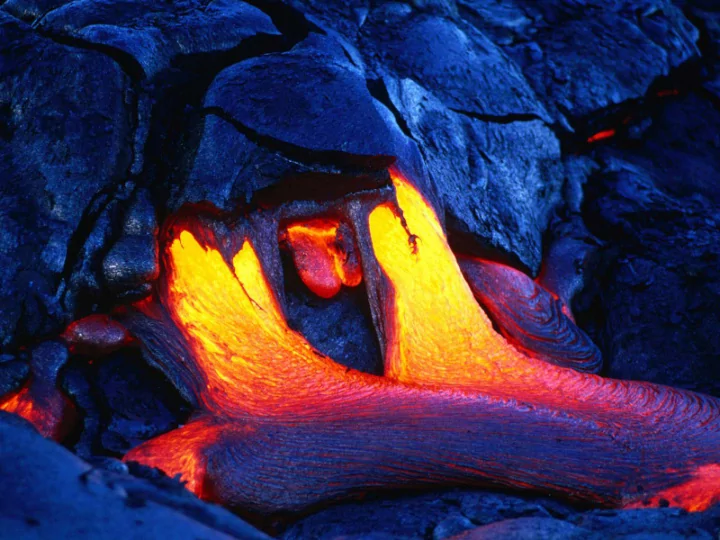

Example of Black Body Spectra for different temperatures
What is the best known example of a black body source?
What is the best known example of a black body source? Hint Temperature = 2.7 K
Planck Radiation Law Cosmic Microwave Background (Radiation from Big Bang! T=2.725K. The theoretical curve obscures the data points and the error bars. Astrophysical Journal, 473 , 576
Question: What is the energy quantization of a grandfather clock? Hint:
Question: What is the energy quantization of a grandfather clock? Hint: E=nh ν for n=1, ν =1Hz=1s -1 E= 6.6x10 -34 J
E=nh ν for n=1, ν =1Hz=1s -1 E= 6.6x10 -34 J How is the quantization realized?
E=nh ν for n=1, ν =1Hz=1s -1 E= 6.6x10 -34 J How does this quantization translate into quantization of the pendulum displacement (height)?
E=nh ν for n=1, ν =1Hz=1s -1 E= 6.6x10 -34 J How does this quantization translate into quantization of the pendulum displacement (height)? E=mgH=6.6x10 -34 J H=6.6x10 -34 J/(1kg 10m/s 2 )=6.6x10 -35 m H Too small to measure (size of an atom is about 10 -8 m)
Configuration Prediction Observation (Classical) Brighter Light Very Bright Red Light Change Color Time until emission of electricity Metal
Configuration Prediction Observation (Classical) Brighter Light More Electricity Faster electrons Very Bright Red More Electricity Light Change Color No Effect Time until emission Few Seconds Metal of electricity
Configuration Prediction Observation (Classical) Brighter Light More Electricity YES Faster electrons NO Very Bright Red More Electricity No electricity Light Change Color No Effect Big Effect Time until emission Few Seconds Instantaneous Metal (~10 -9 s) of electricity
Emission and Absorption of Light evidence for quantization Max Planck Albert Einstein Robert Millikan 1858-1947 1879-1955 1868-1953 Nobel Prize in Physics 1918 Nobel Prize in Physics 1921 Nobel Prize in Physics 1923 "in recognition of the "for his services to "for his work on the elementary services he rendered to Theoretical Physics, and charge of electricity and on the the advancement of especially for his discovery photoelectric effect " Physics by his discovery of the law of the of energy quanta ". photoelectric effect "
Diagram of Millikan’s Device For measuring photoelectric effect
Data from Millikan’s 1916 Article
Phys. Rev. 7, 355–388 (1916)
Example Problem The work functions for K and Zn are 2.26 eV and 4.24 eV Which will emit photoelectrons when illuminated by Red, Blue and UV light? Wavelength K (2.26 eV) Zn (4.24 eV) Red (700 nm) Blue (400 nm) UV (280 nm) E=h ν -w=0 hc=1240eV nm Energy of photon is h ν or hc/ λ or 1240 eV nm/ λ
Example Problem The work functions for K and Zn are 2.26 eV and 4.24 eV Which will emit photoelectrons when illuminated by Red, Blue and UV light? Wavelength K (2.26 eV) Zn (4.24 eV) ? Photon Red (700 nm) Photoelectron? If (hc/ λ− w) > 0 E= hc/ λ Blue (400 nm) UV (280 nm) E=h ν -w=0 hc=1240eV nm Energy of photon is h ν or hc/ λ or 1240 eV nm/ λ
Example Problem The work functions for K and Zn are 2.26 eV and 4.24 eV Which will emit photoelectrons when illuminated by Red, Blue and UV light? Wavelength K (2.26 eV) Zn (4.24 eV) ? Red (700 nm) 1.77 eV NO NO Photon Photoelectron? If (hc/ λ− w) > 0 E= hc/ λ Blue (400 nm) 3.10 eV YES NO UV (280 nm) 4.42 eV YES YES E=h ν -w=0 hc=1240eV nm Energy of photon is h ν or hc/ λ or 1240 eV nm/ λ
Recommend
More recommend